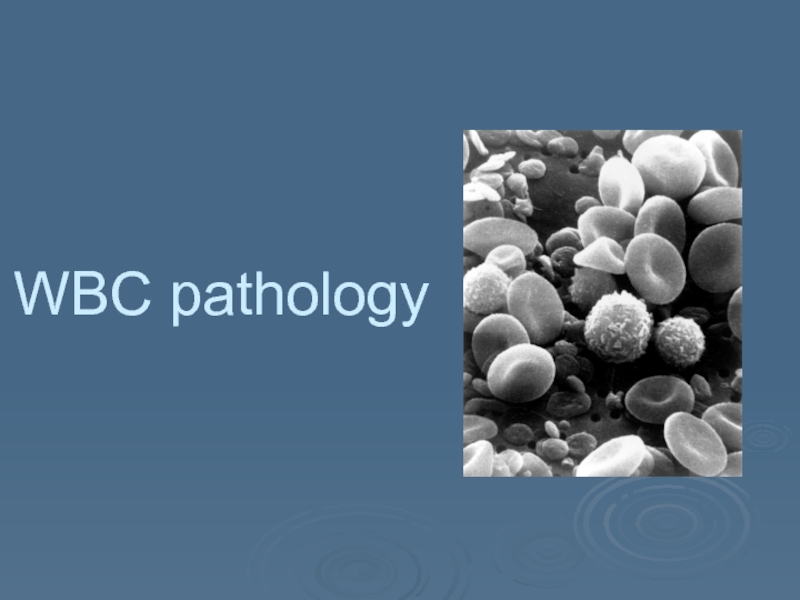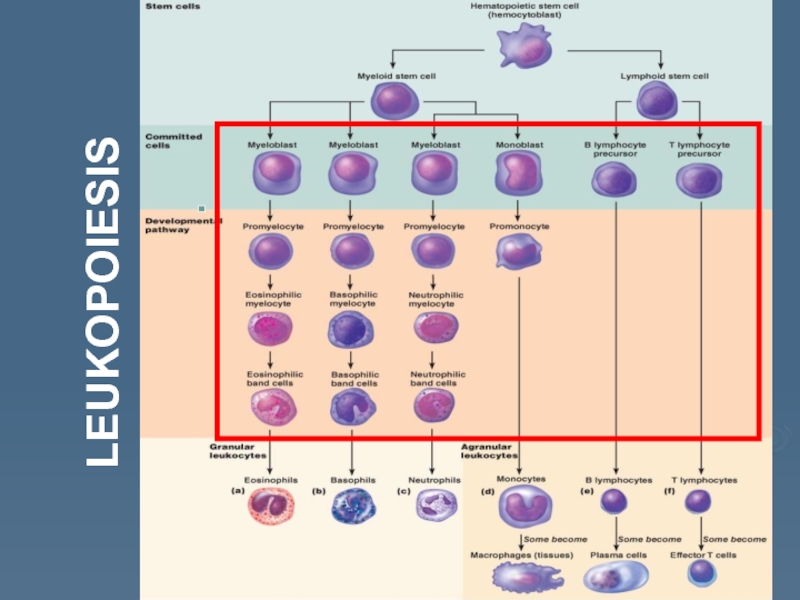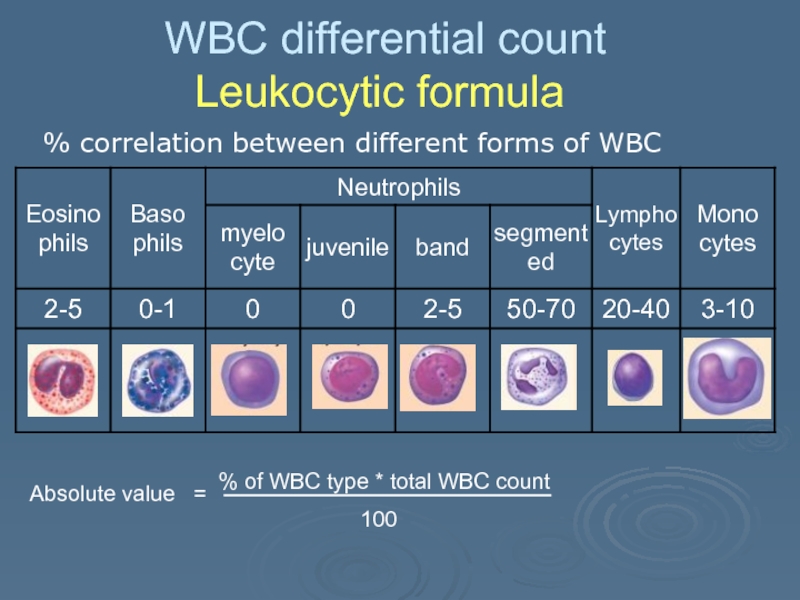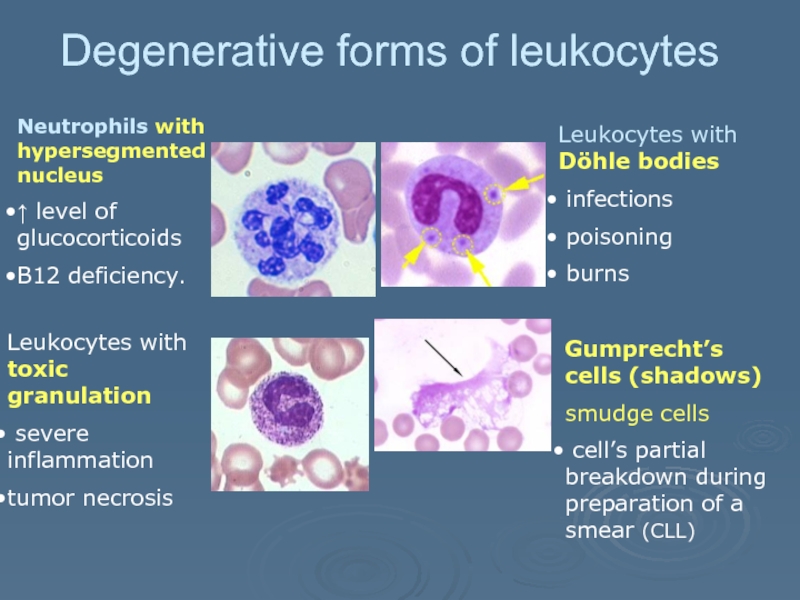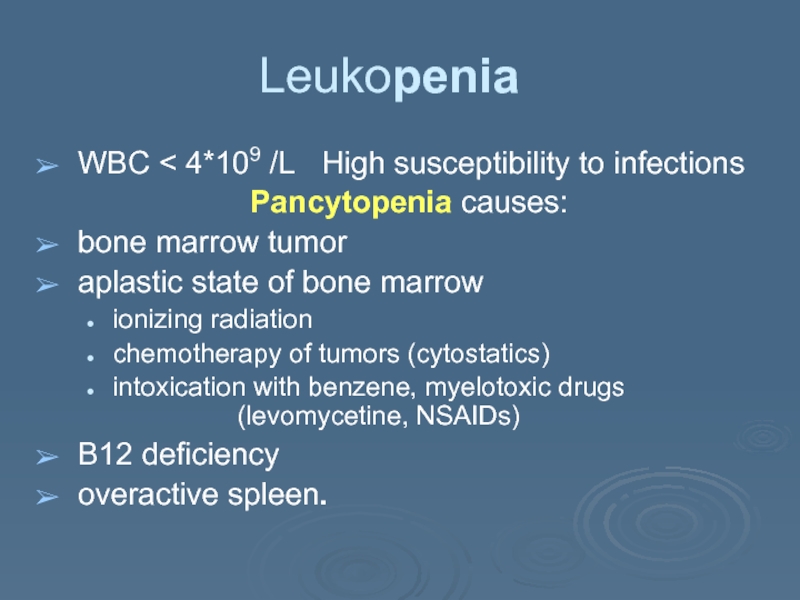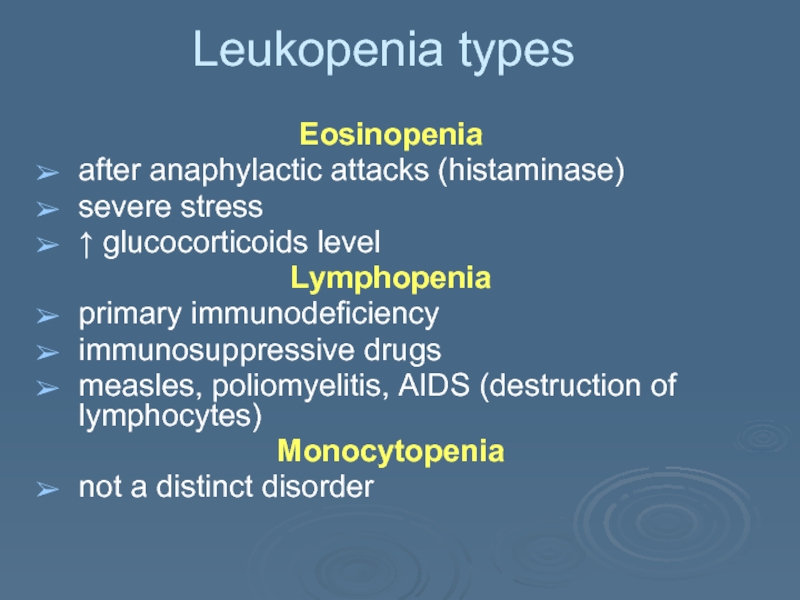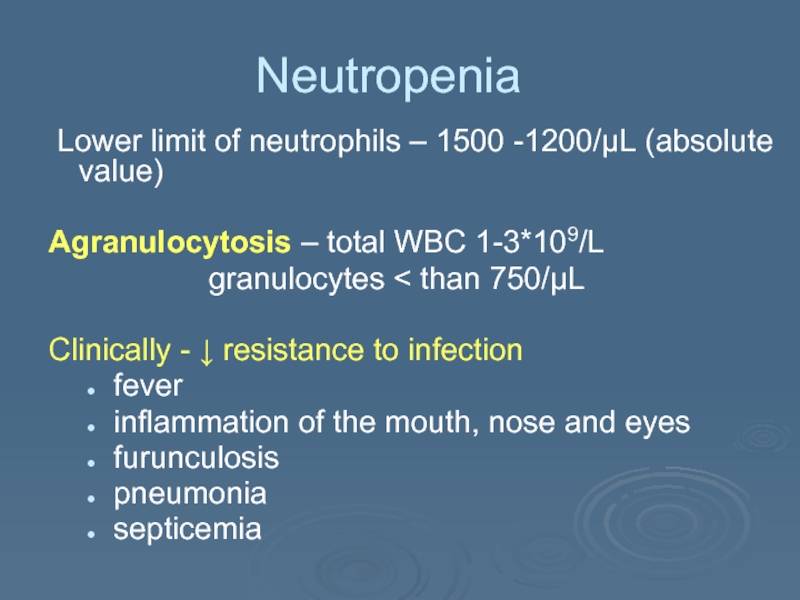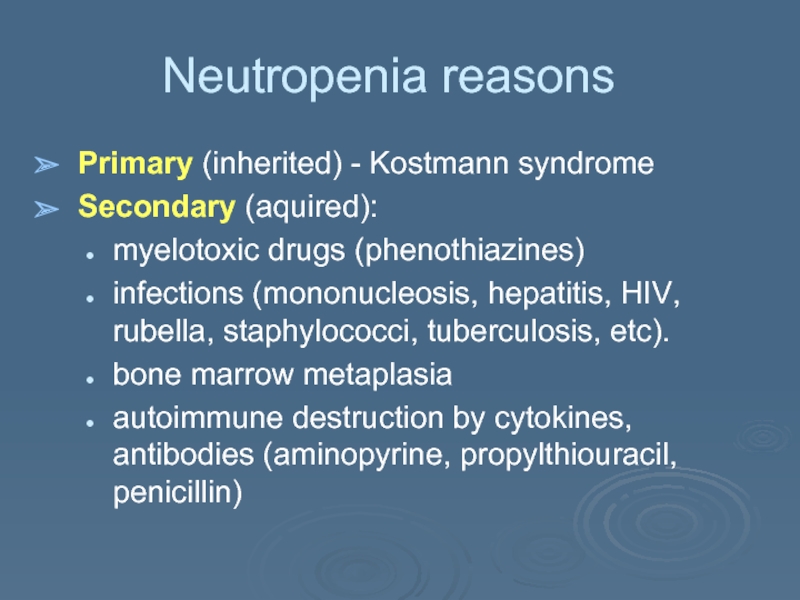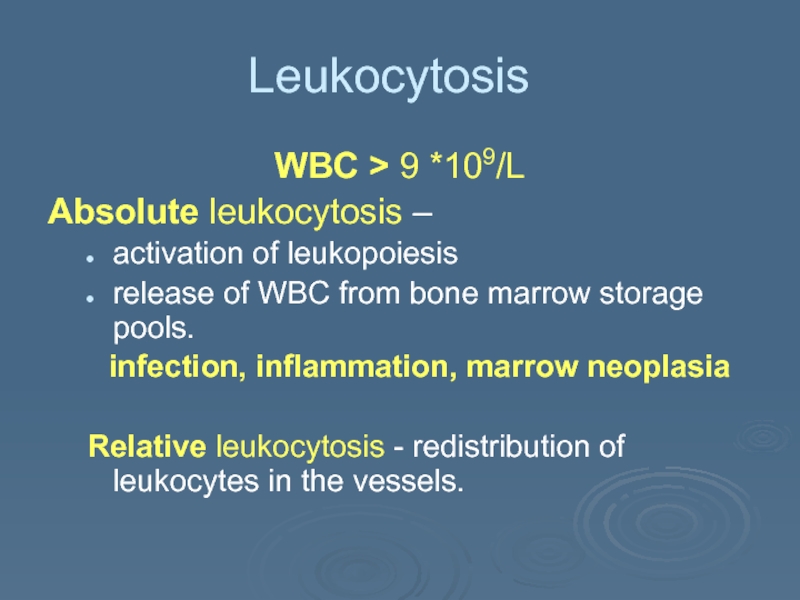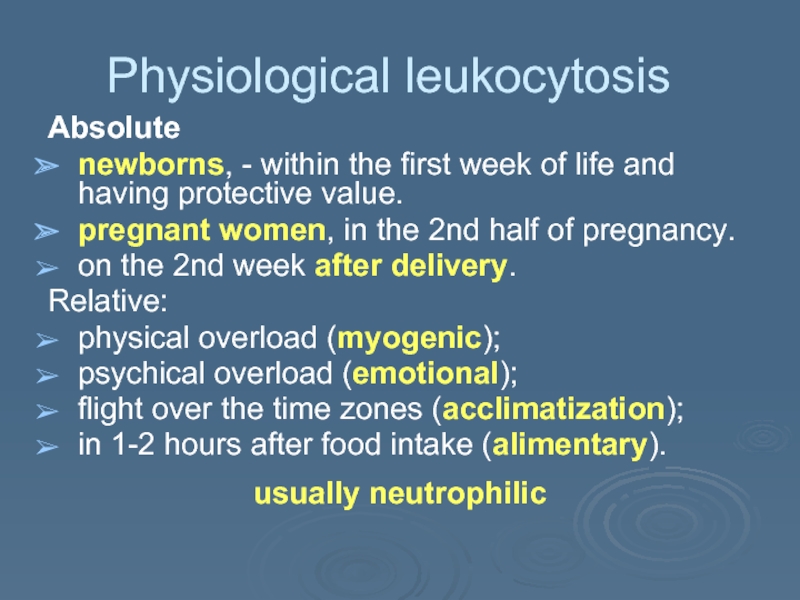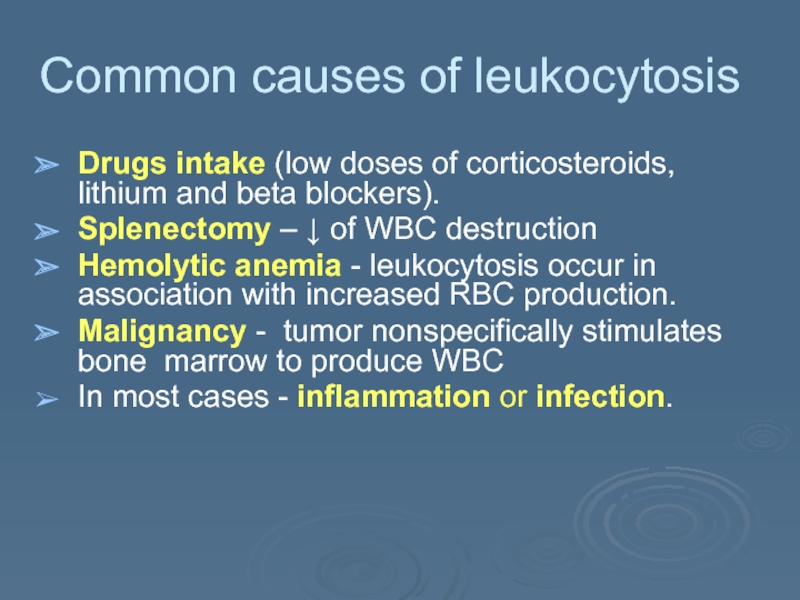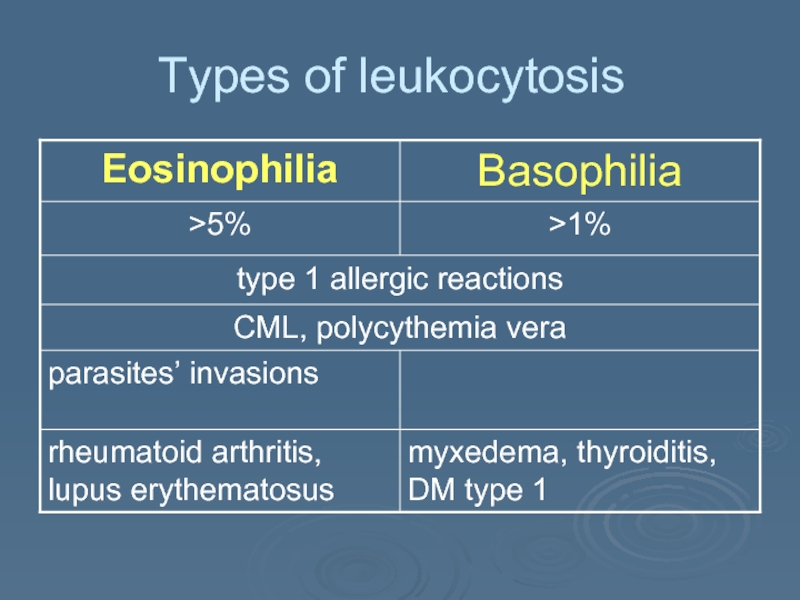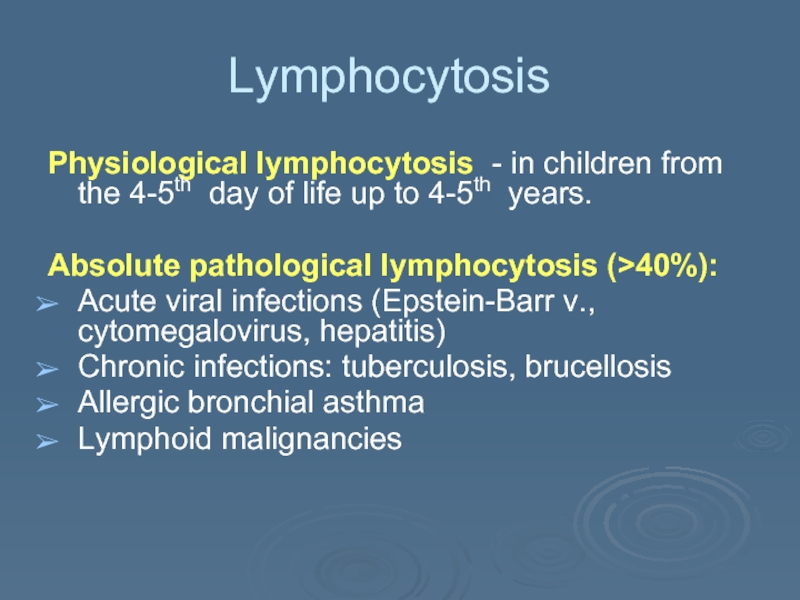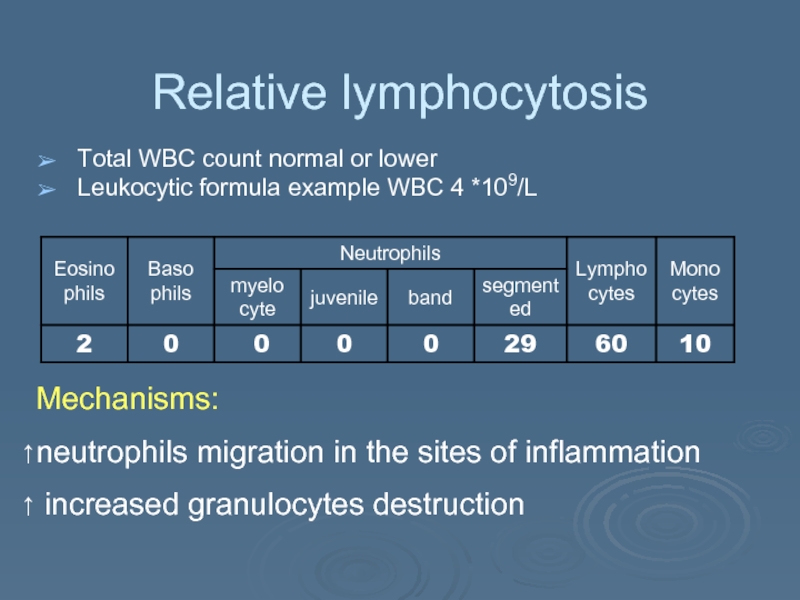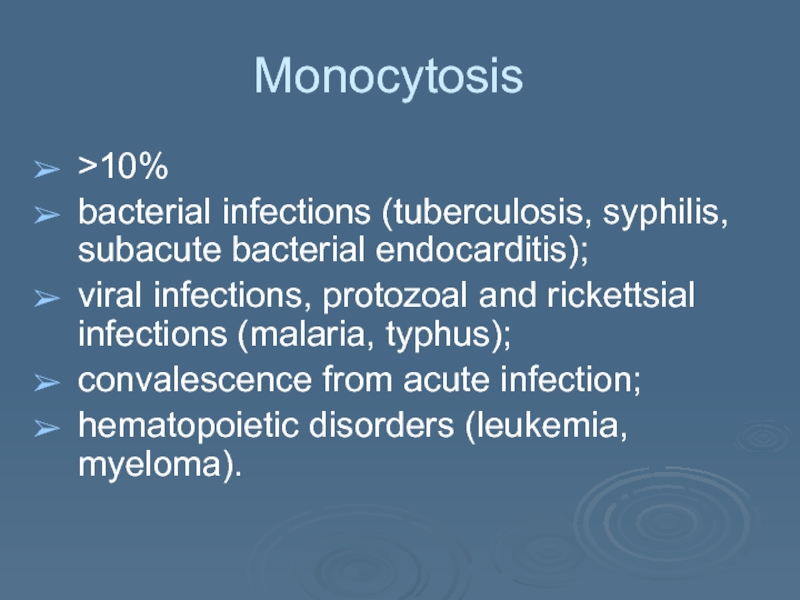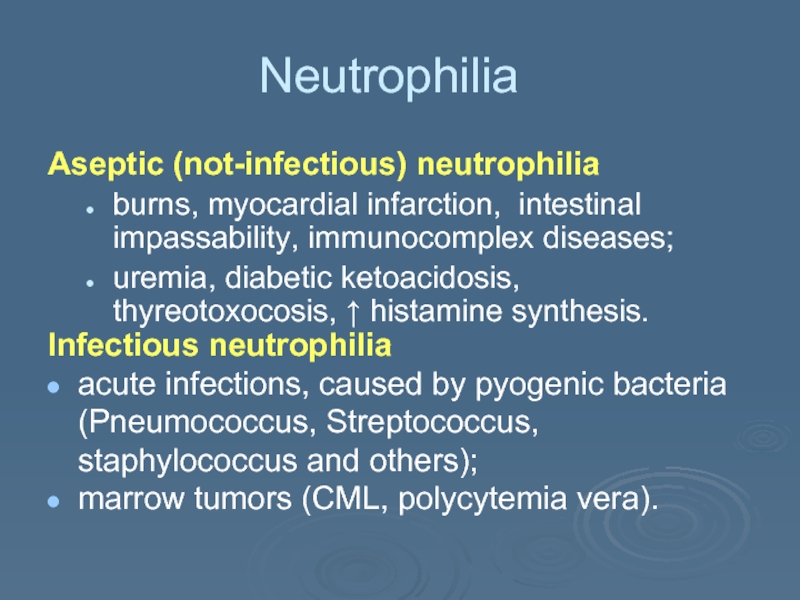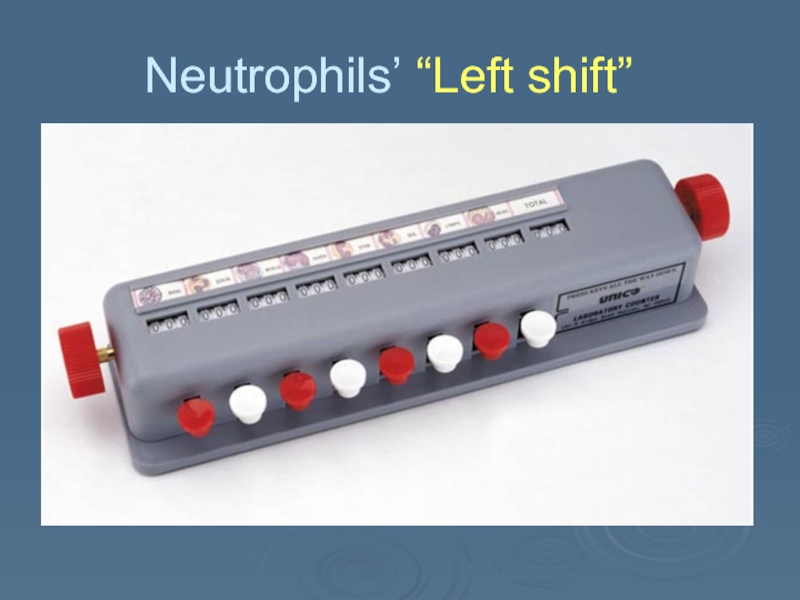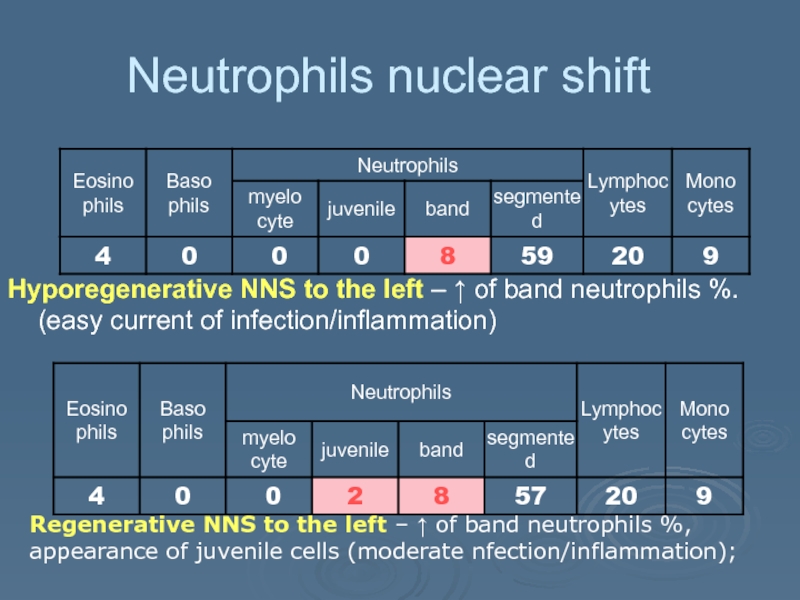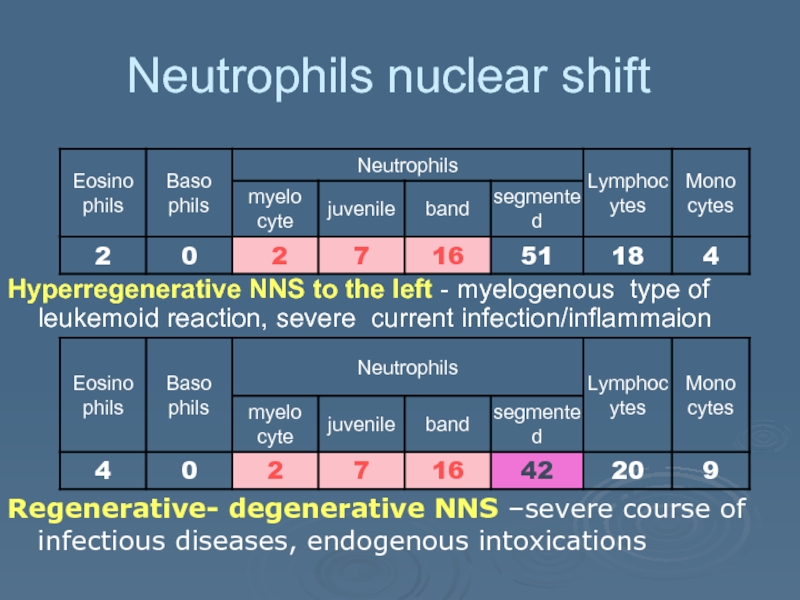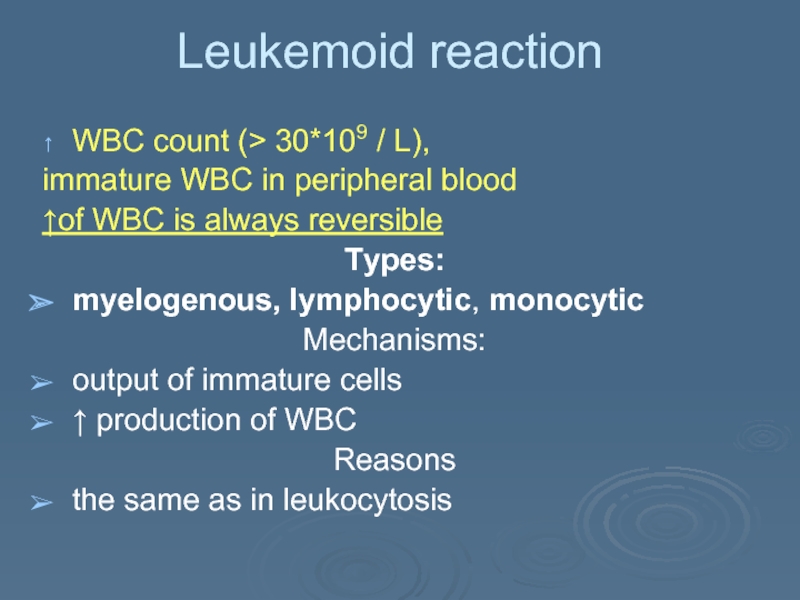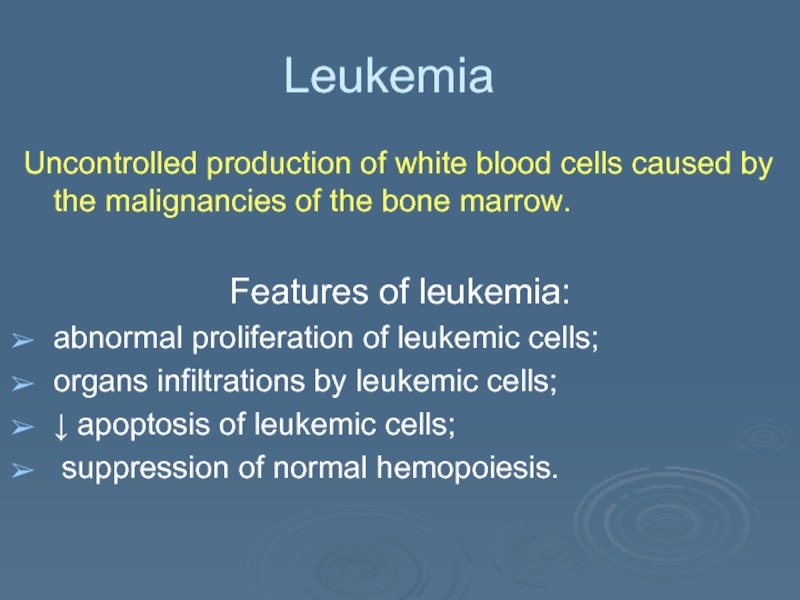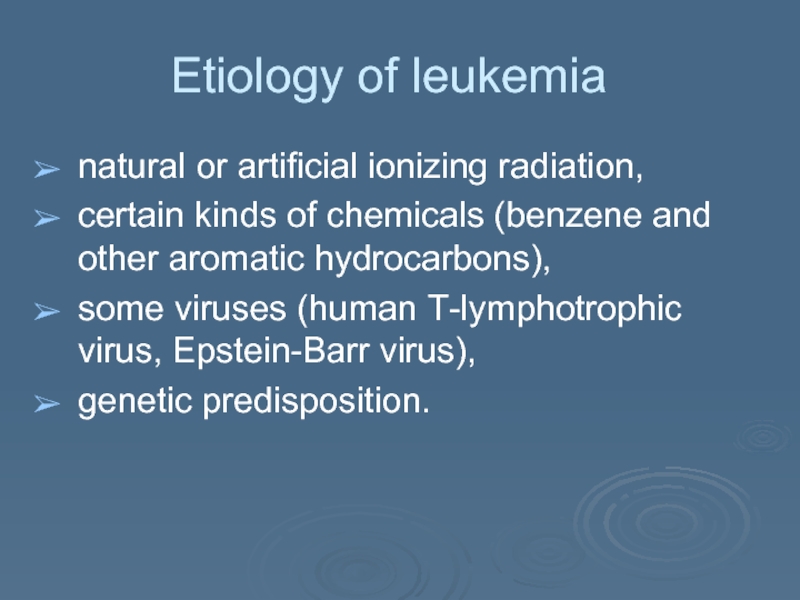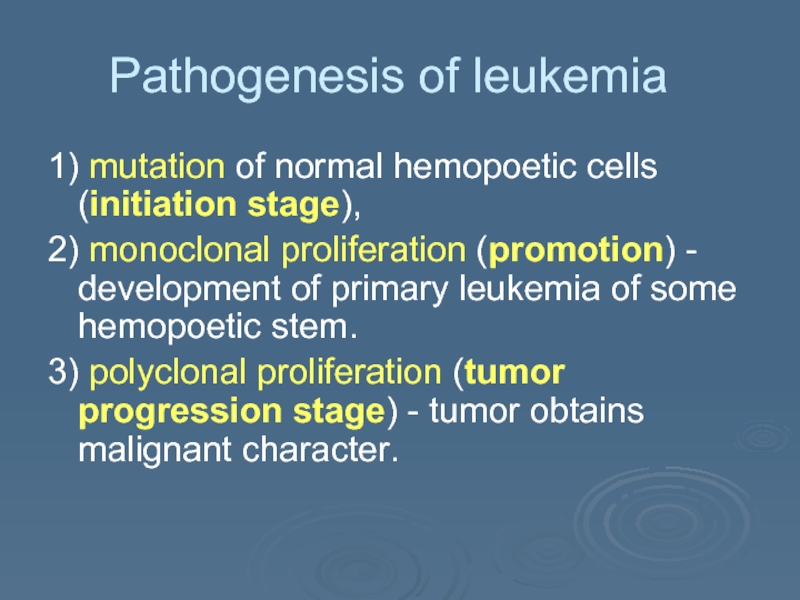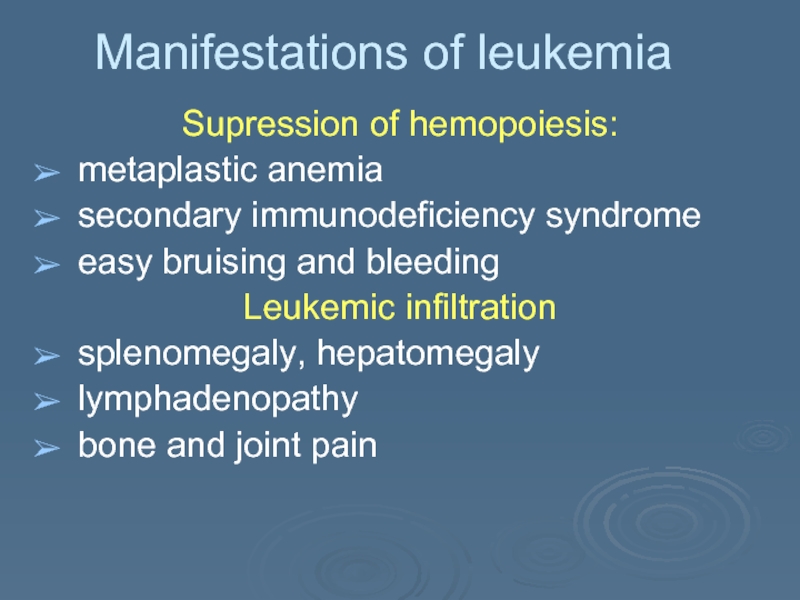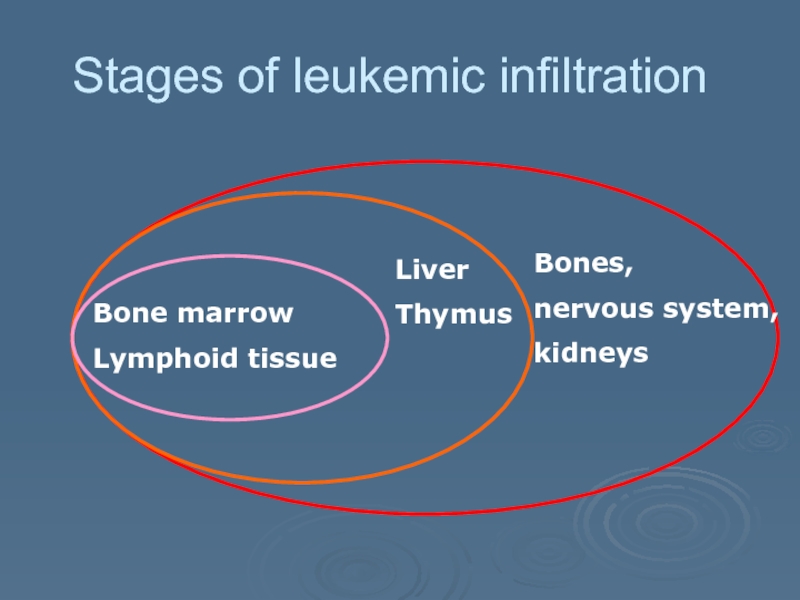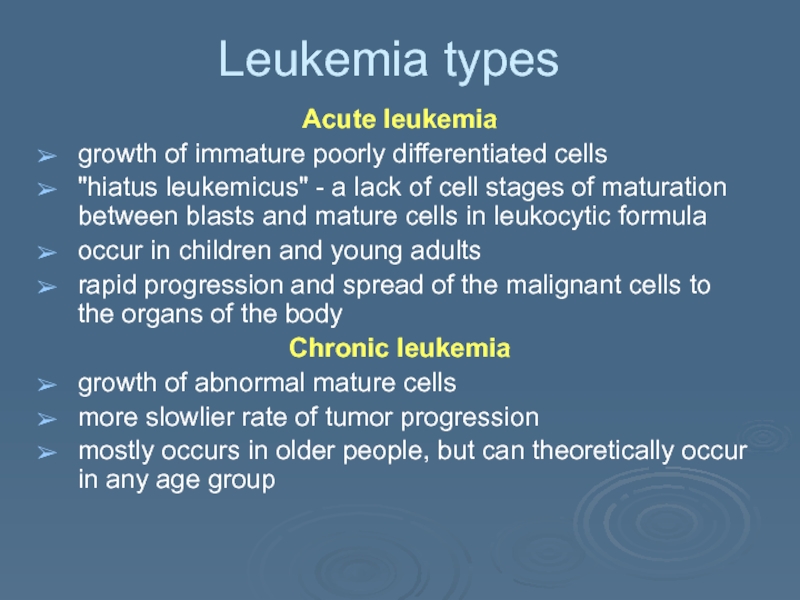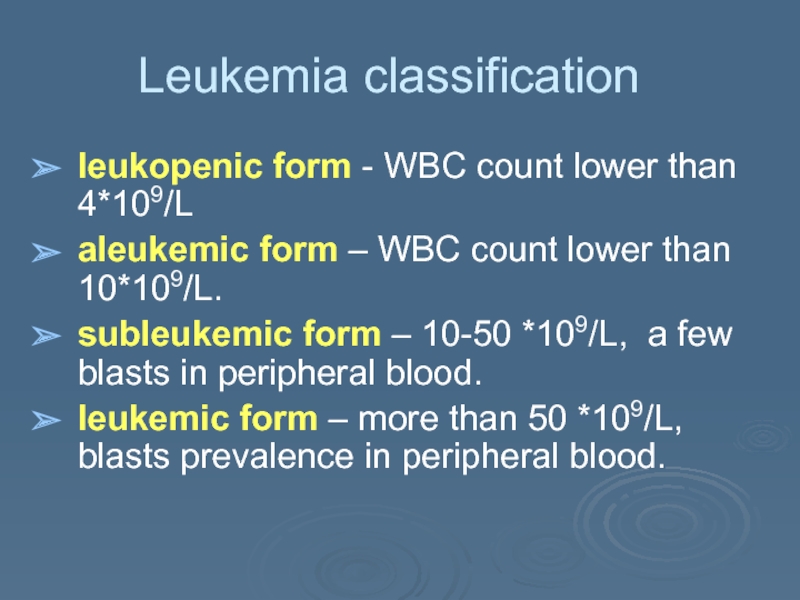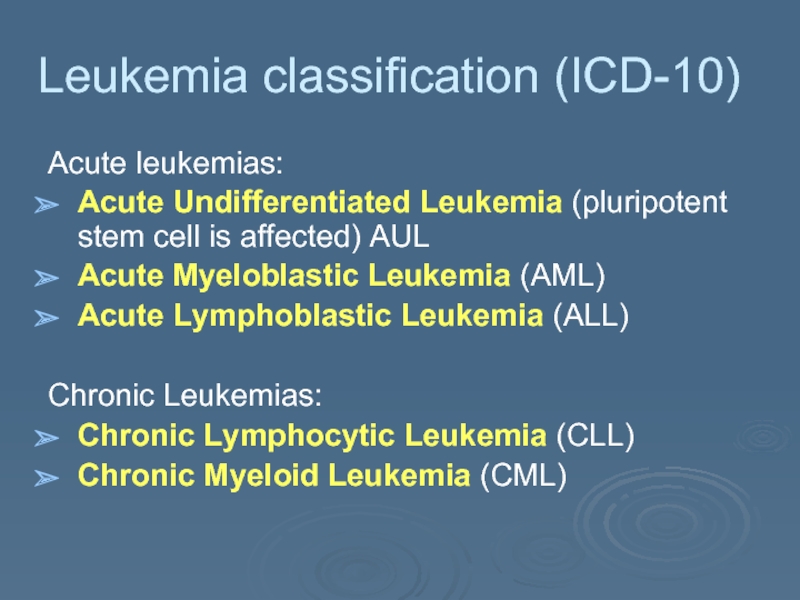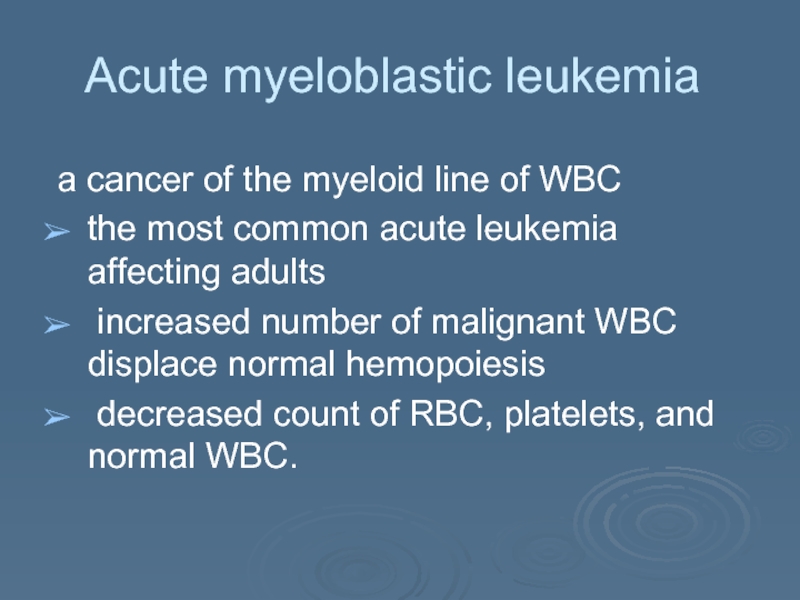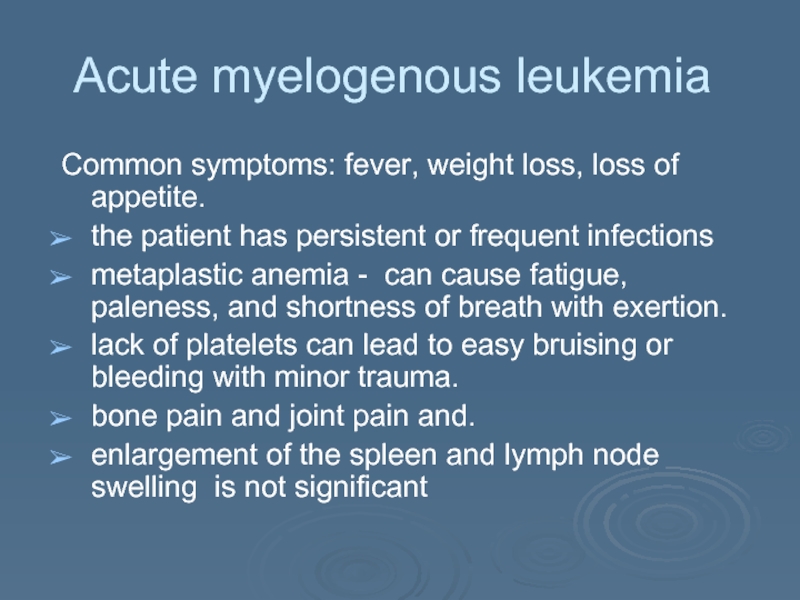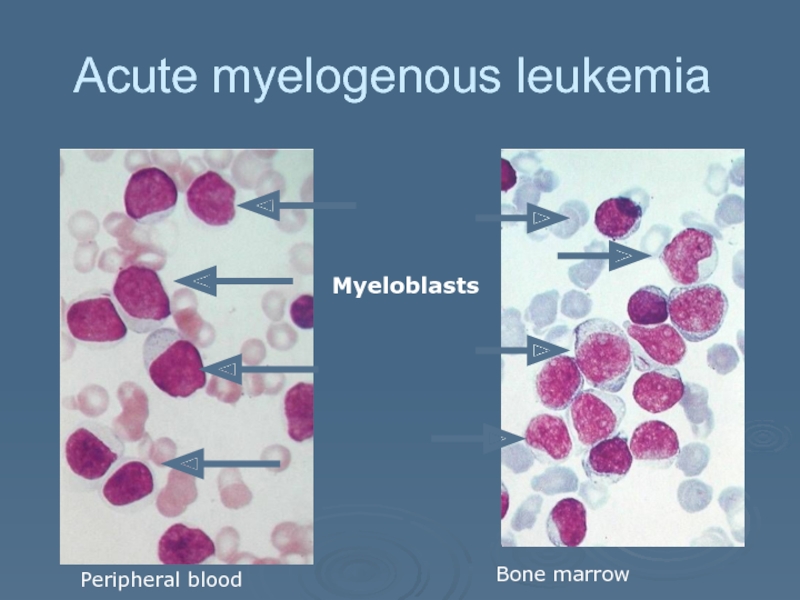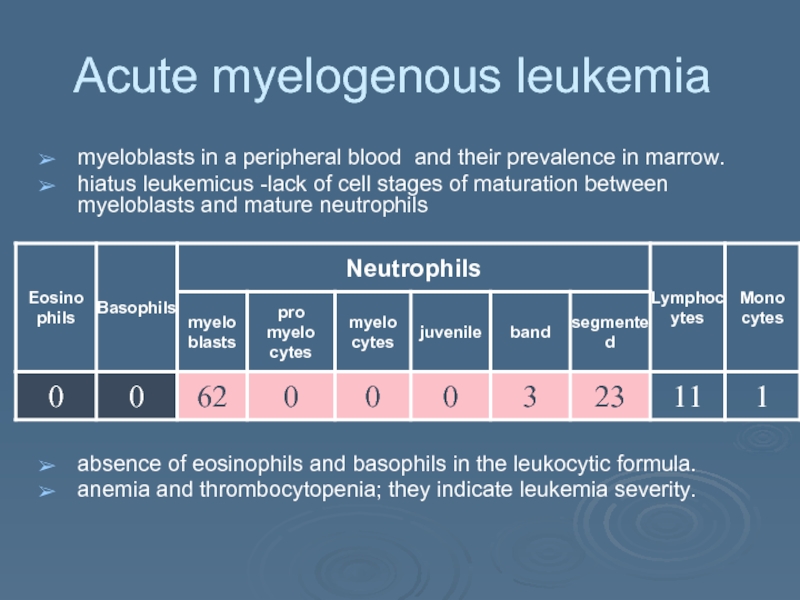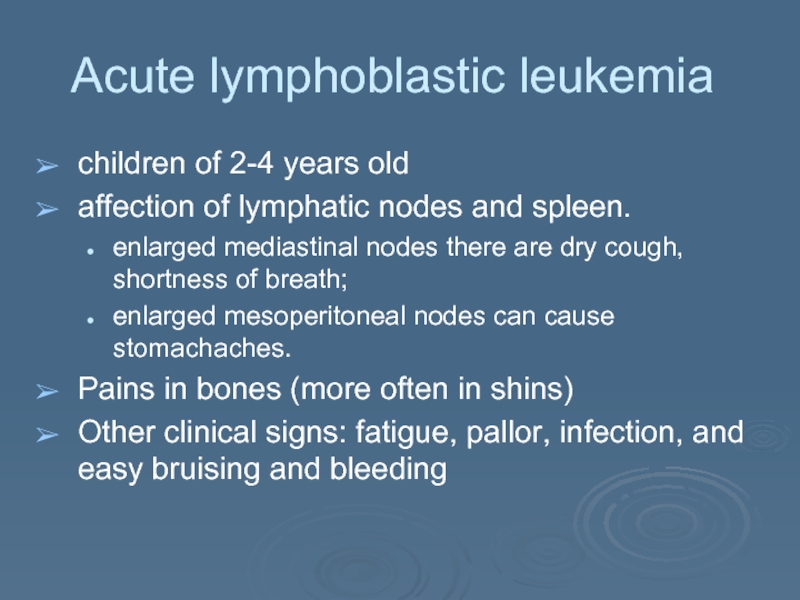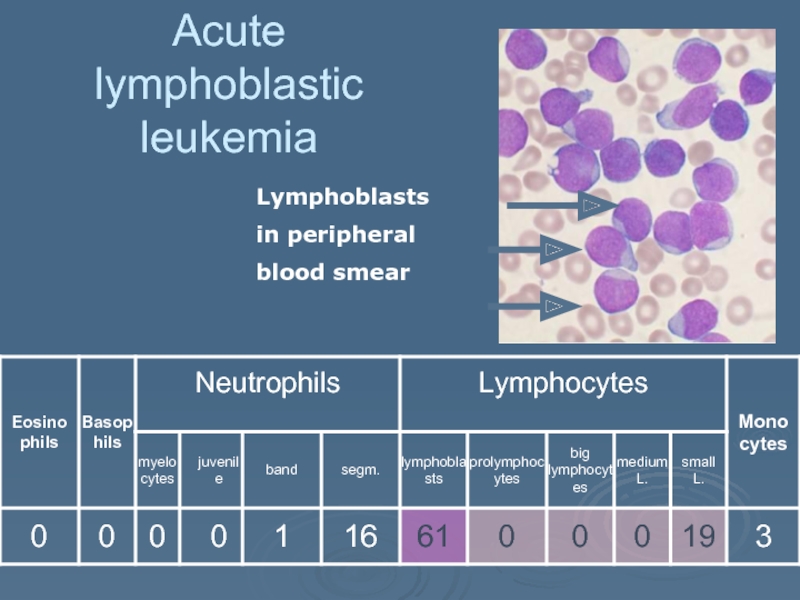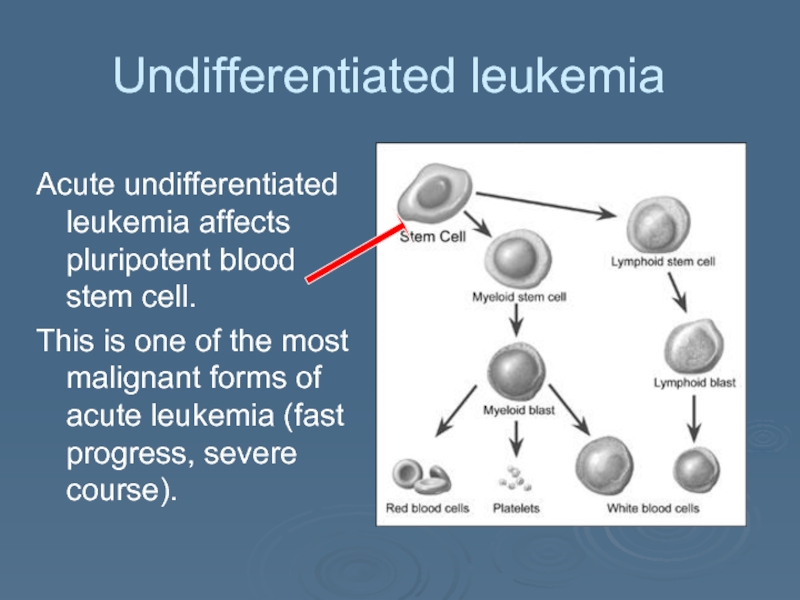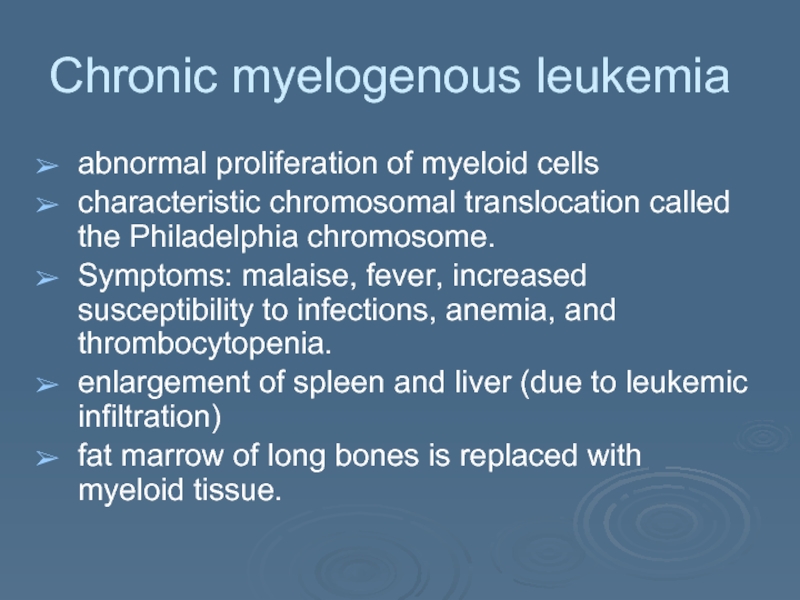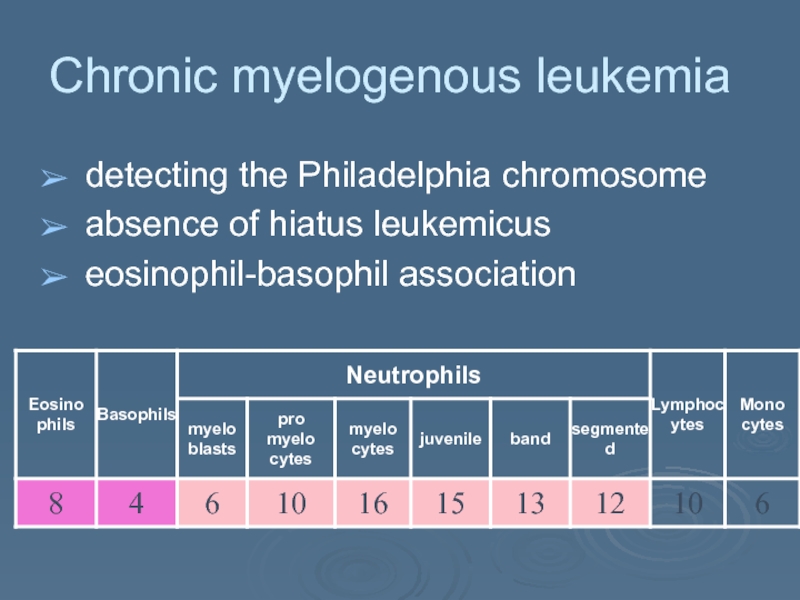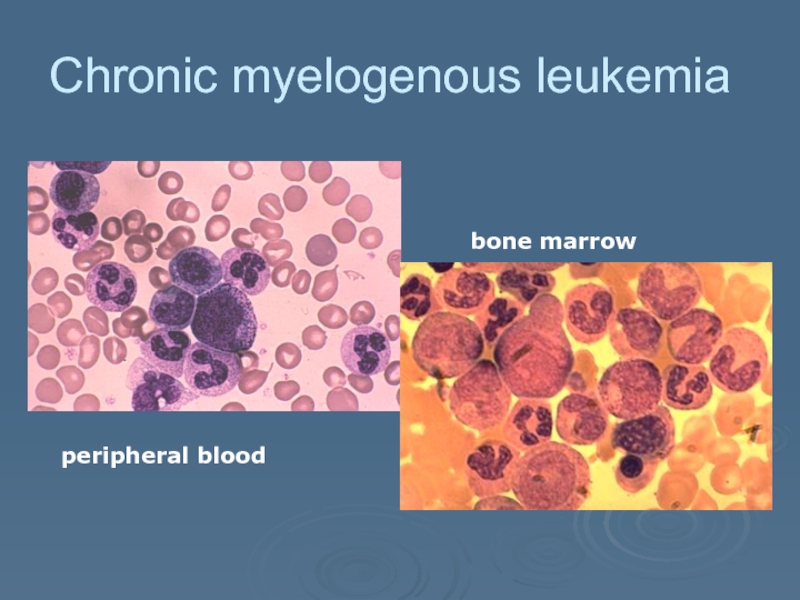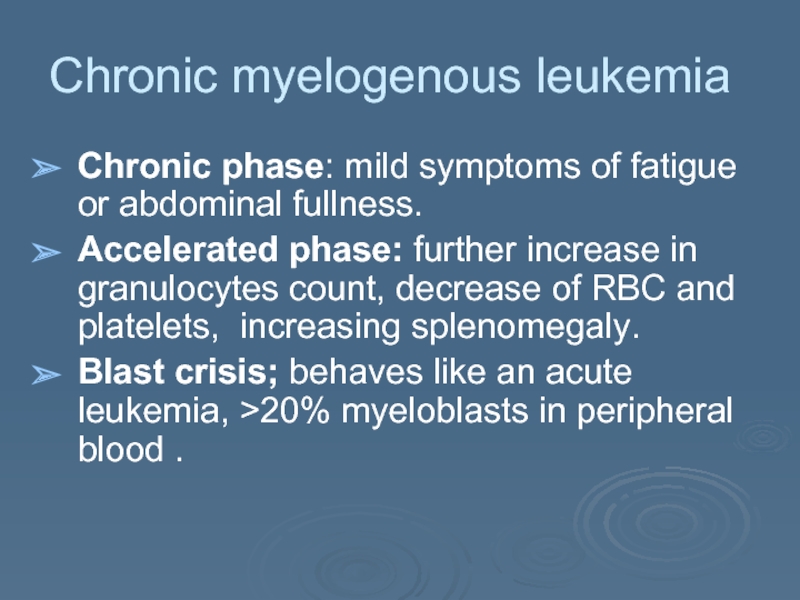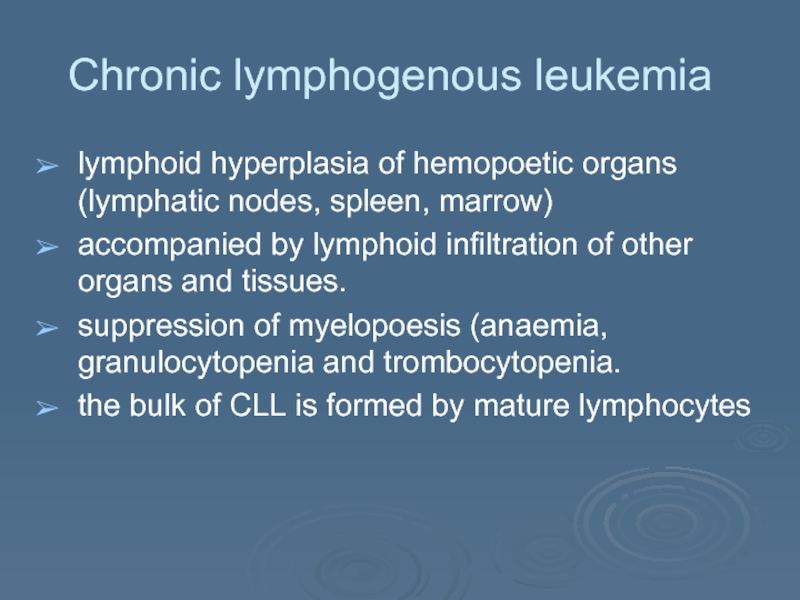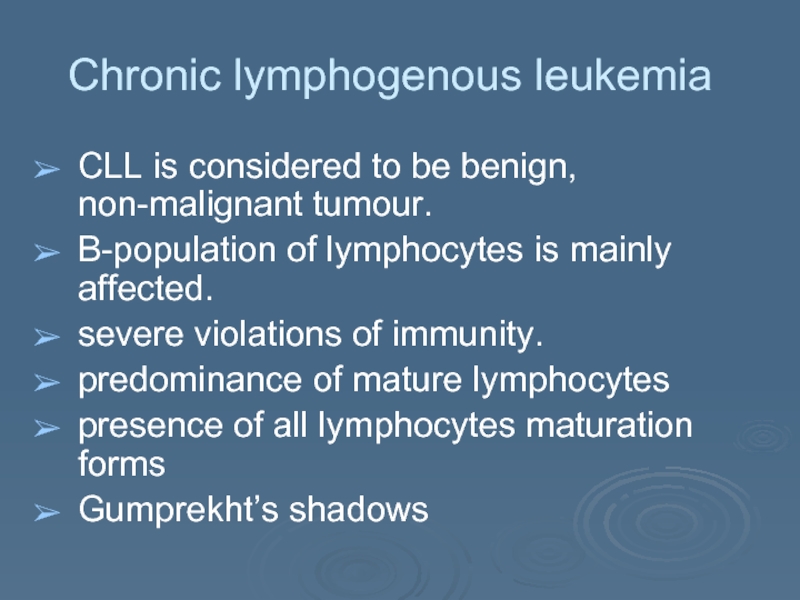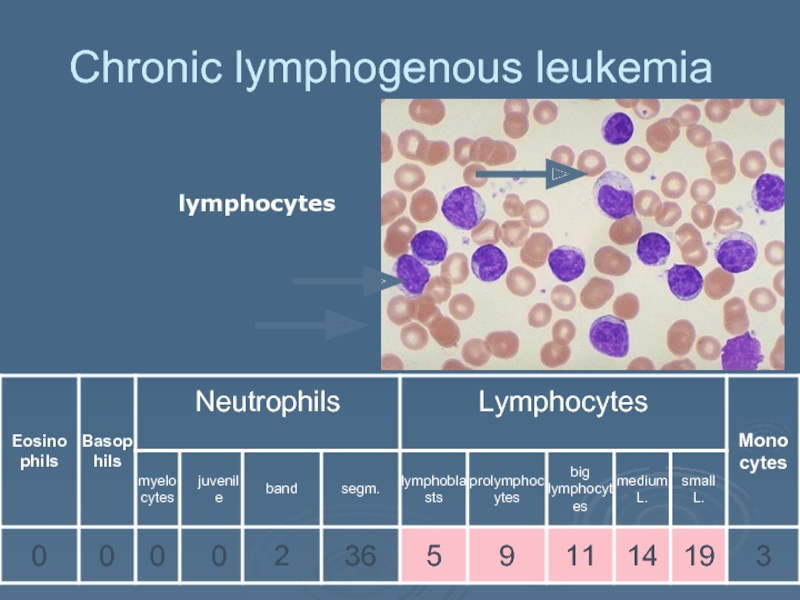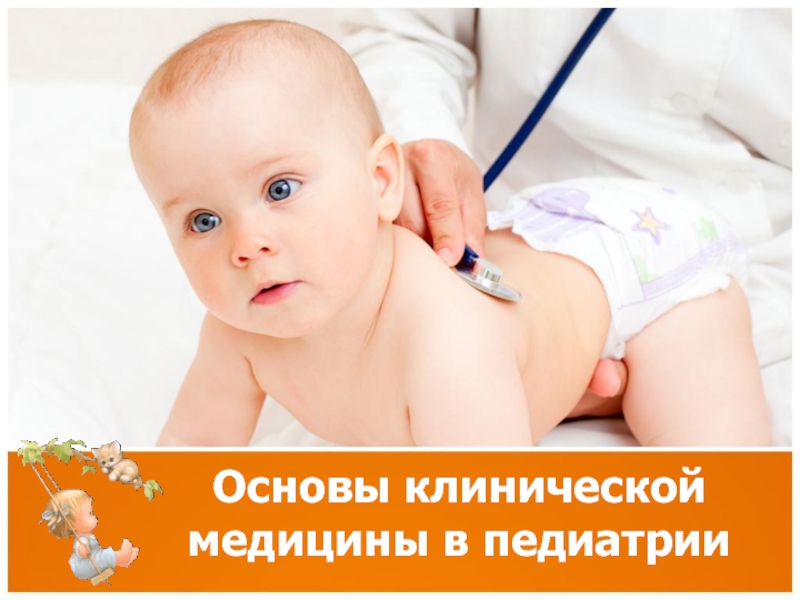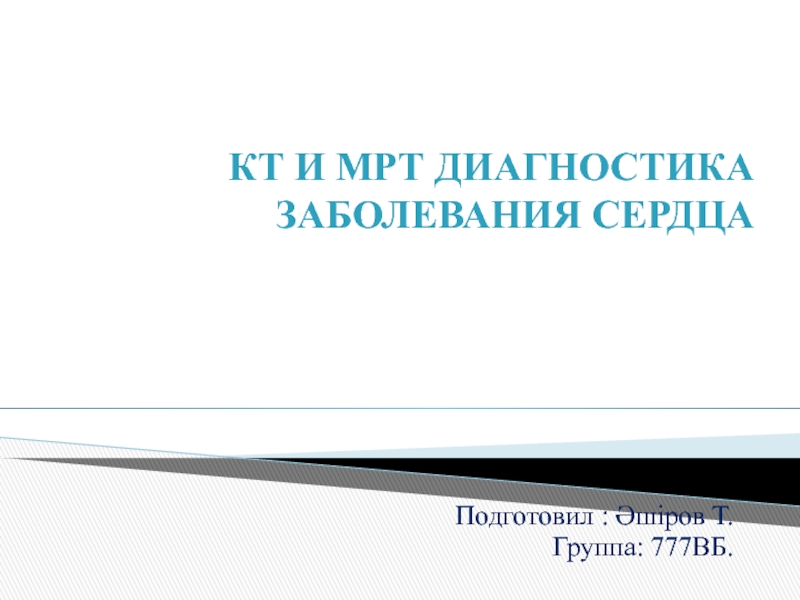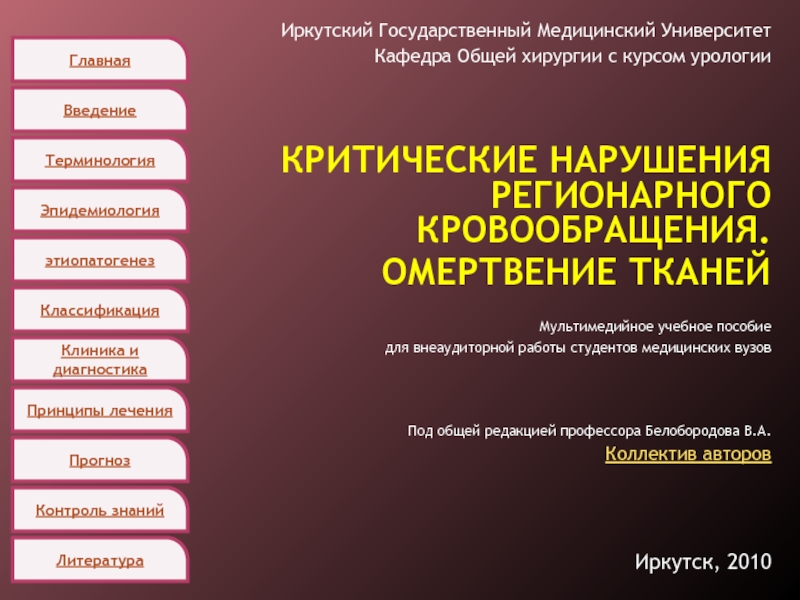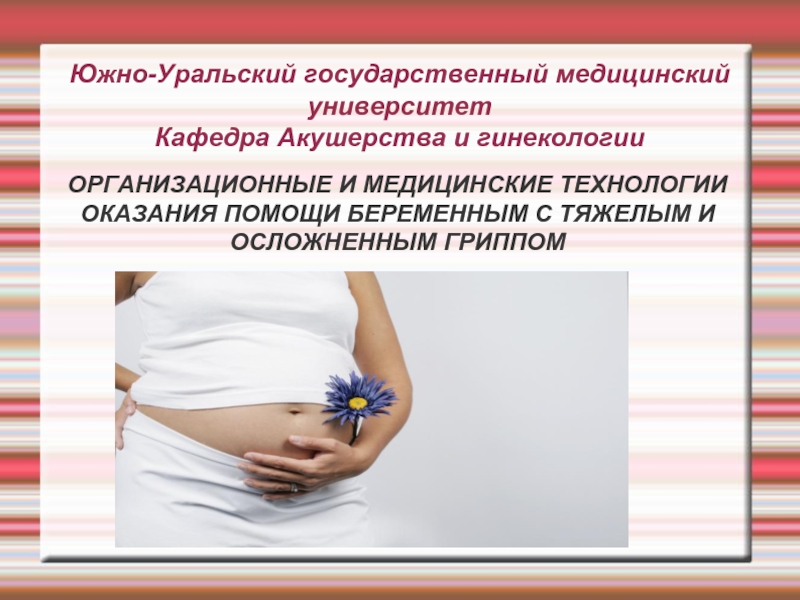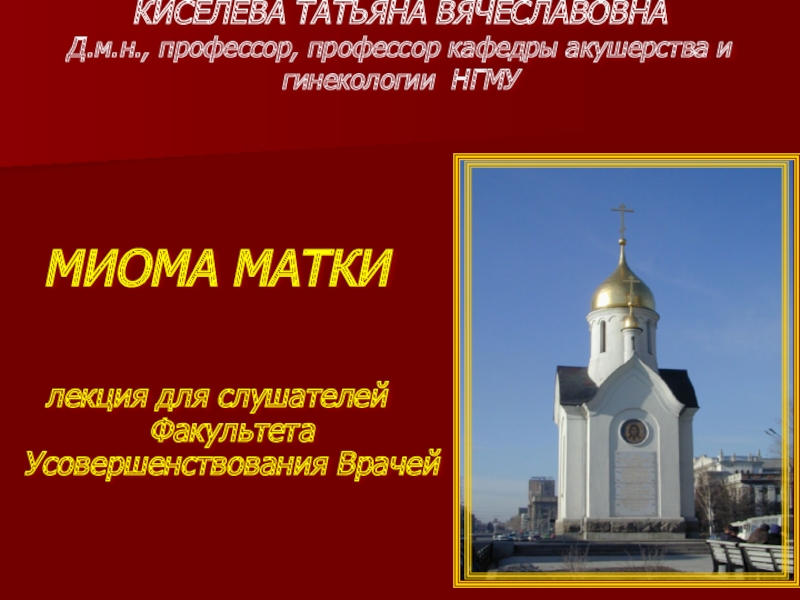- Главная
- Разное
- Дизайн
- Бизнес и предпринимательство
- Аналитика
- Образование
- Развлечения
- Красота и здоровье
- Финансы
- Государство
- Путешествия
- Спорт
- Недвижимость
- Армия
- Графика
- Культурология
- Еда и кулинария
- Лингвистика
- Английский язык
- Астрономия
- Алгебра
- Биология
- География
- Детские презентации
- Информатика
- История
- Литература
- Маркетинг
- Математика
- Медицина
- Менеджмент
- Музыка
- МХК
- Немецкий язык
- ОБЖ
- Обществознание
- Окружающий мир
- Педагогика
- Русский язык
- Технология
- Физика
- Философия
- Химия
- Шаблоны, картинки для презентаций
- Экология
- Экономика
- Юриспруденция
WBC pathology. (Subject 11) презентация
Содержание
- 1. WBC pathology. (Subject 11)
- 2. LEUKOPOIESIS
- 3. WBC differential count Leukocytic formula
- 4. Degenerative forms of leukocytes Leukocytes with Döhle
- 5. Leukopenia WBC < 4*109 /L
- 6. Leukopenia types Eosinopenia after anaphylactic attacks
- 7. Neutropenia Lower limit of neutrophils –
- 8. Neutropenia reasons Primary (inherited) - Kostmann syndrome
- 9. Leukocytosis WBC > 9 *109/L Absolute leukocytosis
- 10. Physiological leukocytosis Absolute newborns, - within the
- 11. Common causes of leukocytosis Drugs intake (low
- 12. Types of leukocytosis
- 13. Lymphocytosis Physiological lymphocytosis - in children from
- 14. Relative lymphocytosis Total WBC count normal or
- 15. Monocytosis >10% bacterial infections (tuberculosis, syphilis, subacute
- 16. Neutrophilia Aseptic (not-infectious) neutrophilia burns, myocardial
- 17. Neutrophils’ “Left shift”
- 18. Neutrophils nuclear shift Hyporegenerative NNS to the
- 19. Neutrophils nuclear shift Hyperregenerative NNS to the
- 20. Leukemoid reaction WBC count (> 30*109 /
- 21. Leukemia Uncontrolled production of white blood cells
- 22. Etiology of leukemia natural or artificial
- 23. Pathogenesis of leukemia 1) mutation of
- 24. Manifestations of leukemia Supression of hemopoiesis:
- 25. Stages of leukemic infiltration
- 26. Leukemia types Acute leukemia growth of
- 27. Leukemia classification leukopenic form - WBC count
- 28. Leukemia classification (ICD-10) Acute leukemias: Acute Undifferentiated
- 29. Acute myeloblastic leukemia a cancer of
- 30. Acute myelogenous leukemia Common symptoms: fever, weight
- 31. Acute myelogenous leukemia Myeloblasts Peripheral blood Bone marrow
- 32. Acute myelogenous leukemia myeloblasts in a peripheral
- 33. Acute lymphoblastic leukemia children of 2-4
- 34. Acute lymphoblastic leukemia Lymphoblasts in peripheral blood smear
- 35. Undifferentiated leukemia Acute undifferentiated leukemia affects
- 36. Chronic myelogenous leukemia abnormal proliferation of
- 37. Chronic myelogenous leukemia detecting the Philadelphia chromosome absence of hiatus leukemicus eosinophil-basophil association
- 38. Chronic myelogenous leukemia peripheral blood bone marrow
- 39. Chronic myelogenous leukemia Chronic phase: mild symptoms
- 40. Chronic lymphogenous leukemia lymphoid hyperplasia of
- 41. Chronic lymphogenous leukemia CLL is considered to
- 42. Chronic lymphogenous leukemia lymphocytes
Слайд 3 WBC differential count
Leukocytic formula
% correlation between different forms of WBC
Absolute
% of WBC type * total WBC count
100
Слайд 4Degenerative forms of leukocytes
Leukocytes with Döhle bodies
infections
poisoning
burns
Leukocytes with
severe inflammation
tumor necrosis
Gumprecht’s cells (shadows)
smudge cells
cell’s partial breakdown during preparation of a smear (CLL)
Neutrophils with hypersegmented nucleus
↑ level of glucocorticoids
B12 deficiency.
Слайд 5Leukopenia
WBC < 4*109 /L High susceptibility to infections
Pancytopenia
bone marrow tumor
aplastic state of bone marrow
ionizing radiation
chemotherapy of tumors (cytostatics)
intoxication with benzene, myelotoxic drugs (levomycetine, NSAIDs)
B12 deficiency
overactive spleen.
Слайд 6Leukopenia types
Eosinopenia
after anaphylactic attacks (histaminase)
severe stress
↑ glucocorticoids level
Lymphopenia
primary immunodeficiency
immunosuppressive
measles, poliomyelitis, AIDS (destruction of lymphocytes)
Monocytopenia
not a distinct disorder
Слайд 7Neutropenia
Lower limit of neutrophils – 1500 -1200/μL (absolute value)
Agranulocytosis –
granulocytes < than 750/μL
Clinically - ↓ resistance to infection
fever
inflammation of the mouth, nose and eyes
furunculosis
pneumonia
septicemia
Слайд 8Neutropenia reasons
Primary (inherited) - Kostmann syndrome
Secondary (aquired):
myelotoxic drugs (phenothiazines)
infections (mononucleosis,
bone marrow metaplasia
autoimmune destruction by cytokines, antibodies (aminopyrine, propylthiouracil, penicillin)
Слайд 9Leukocytosis
WBC > 9 *109/L
Absolute leukocytosis –
activation of leukopoiesis
release of WBC
infection, inflammation, marrow neoplasia
Relative leukocytosis - redistribution of leukocytes in the vessels.
Слайд 10Physiological leukocytosis
Absolute
newborns, - within the first week of life and having
pregnant women, in the 2nd half of pregnancy.
on the 2nd week after delivery.
Relative:
physical overload (myogenic);
psychical overload (emotional);
flight over the time zones (acclimatization);
in 1-2 hours after food intake (alimentary).
usually neutrophilic
Слайд 11Common causes of leukocytosis
Drugs intake (low doses of corticosteroids, lithium and
Splenectomy – ↓ of WBC destruction
Hemolytic anemia - leukocytosis occur in association with increased RBC production.
Malignancy - tumor nonspecifically stimulates bone marrow to produce WBC
In most cases - inflammation or infection.
Слайд 13Lymphocytosis
Physiological lymphocytosis - in children from the 4-5th day of life
Absolute pathological lymphocytosis (>40%):
Acute viral infections (Epstein-Barr v., cytomegalovirus, hepatitis)
Chronic infections: tuberculosis, brucellosis
Allergic bronchial asthma
Lymphoid malignancies
Слайд 14Relative lymphocytosis
Total WBC count normal or lower
Leukocytic formula example WBC 4
Mechanisms:
neutrophils migration in the sites of inflammation
increased granulocytes destruction
Слайд 15Monocytosis
>10%
bacterial infections (tuberculosis, syphilis, subacute bacterial endocarditis);
viral infections, protozoal and rickettsial
convalescence from acute infection;
hematopoietic disorders (leukemia, myeloma).
Слайд 16Neutrophilia
Aseptic (not-infectious) neutrophilia
burns, myocardial infarction, intestinal impassability, immunocomplex diseases;
uremia, diabetic
Infectious neutrophilia
acute infections, caused by pyogenic bacteria (Pneumococcus, Streptococcus, staphylococcus and others);
marrow tumors (CML, polycytemia vera).
Слайд 18Neutrophils nuclear shift
Hyporegenerative NNS to the left – ↑ of band
Regenerative NNS to the left – ↑ of band neutrophils %, appearance of juvenile cells (moderate nfection/inflammation);
Слайд 19Neutrophils nuclear shift
Hyperregenerative NNS to the left - myelogenous type of
Regenerative- degenerative NNS –severe course of infectious diseases, endogenous intoxications
Слайд 20Leukemoid reaction
WBC count (> 30*109 / L),
immature WBC in peripheral
↑of WBC is always reversible
Types:
myelogenous, lymphocytic, monocytic
Mechanisms:
output of immature cells
↑ production of WBC
Reasons
the same as in leukocytosis
Слайд 21Leukemia
Uncontrolled production of white blood cells caused by the malignancies of
Features of leukemia:
abnormal proliferation of leukemic cells;
organs infiltrations by leukemic cells;
↓ apoptosis of leukemic cells;
suppression of normal hemopoiesis.
Слайд 22Etiology of leukemia
natural or artificial ionizing radiation,
certain kinds of
some viruses (human T-lymphotrophic virus, Epstein-Barr virus),
genetic predisposition.
Слайд 23Pathogenesis of leukemia
1) mutation of normal hemopoetic cells (initiation stage),
2) monoclonal proliferation (promotion) - development of primary leukemia of some hemopoetic stem.
3) polyclonal proliferation (tumor progression stage) - tumor obtains malignant character.
Слайд 24Manifestations of leukemia
Supression of hemopoiesis:
metaplastic anemia
secondary immunodeficiency syndrome
easy bruising and
Leukemic infiltration
splenomegaly, hepatomegaly
lymphadenopathy
bone and joint pain
Слайд 25Stages of leukemic infiltration
Bone marrow
Lymphoid tissue
Liver
Thymus
Bones,
nervous system,
kidneys
Слайд 26Leukemia types
Acute leukemia
growth of immature poorly differentiated cells
"hiatus leukemicus" -
occur in children and young adults
rapid progression and spread of the malignant cells to the organs of the body
Chronic leukemia
growth of abnormal mature cells
more slowlier rate of tumor progression
mostly occurs in older people, but can theoretically occur in any age group
Слайд 27Leukemia classification
leukopenic form - WBC count lower than 4*109/L
aleukemic form –
subleukemic form – 10-50 *109/L, a few blasts in peripheral blood.
leukemic form – more than 50 *109/L, blasts prevalence in peripheral blood.
Слайд 28Leukemia classification (ICD-10)
Acute leukemias:
Acute Undifferentiated Leukemia (pluripotent stem cell is affected)
Acute Myeloblastic Leukemia (AML)
Acute Lymphoblastic Leukemia (ALL)
Chronic Leukemias:
Chronic Lymphocytic Leukemia (CLL)
Chronic Myeloid Leukemia (CML)
Слайд 29Acute myeloblastic leukemia
a cancer of the myeloid line of WBC
the most common acute leukemia affecting adults
increased number of malignant WBC displace normal hemopoiesis
decreased count of RBC, platelets, and normal WBC.
Слайд 30Acute myelogenous leukemia
Common symptoms: fever, weight loss, loss of appetite.
the
metaplastic anemia - can cause fatigue, paleness, and shortness of breath with exertion.
lack of platelets can lead to easy bruising or bleeding with minor trauma.
bone pain and joint pain and.
enlargement of the spleen and lymph node swelling is not significant
Слайд 32Acute myelogenous leukemia
myeloblasts in a peripheral blood and their prevalence in
hiatus leukemicus -lack of cell stages of maturation between myeloblasts and mature neutrophils
absence of eosinophils and basophils in the leukocytic formula.
anemia and thrombocytopenia; they indicate leukemia severity.
Слайд 33Acute lymphoblastic leukemia
children of 2-4 years old
affection of lymphatic nodes
enlarged mediastinal nodes there are dry cough, shortness of breath;
enlarged mesoperitoneal nodes can cause stomachaches.
Pains in bones (more often in shins)
Other clinical signs: fatigue, pallor, infection, and easy bruising and bleeding
Слайд 35Undifferentiated leukemia
Acute undifferentiated leukemia affects pluripotent blood stem cell.
This
Слайд 36Chronic myelogenous leukemia
abnormal proliferation of myeloid cells
characteristic chromosomal translocation called
Symptoms: malaise, fever, increased susceptibility to infections, anemia, and thrombocytopenia.
enlargement of spleen and liver (due to leukemic infiltration)
fat marrow of long bones is replaced with myeloid tissue.
Слайд 37Chronic myelogenous leukemia
detecting the Philadelphia chromosome
absence of hiatus leukemicus
eosinophil-basophil association
Слайд 39Chronic myelogenous leukemia
Chronic phase: mild symptoms of fatigue or abdominal fullness.
Accelerated phase: further increase in granulocytes count, decrease of RBC and platelets, increasing splenomegaly.
Blast crisis; behaves like an acute leukemia, >20% myeloblasts in peripheral blood .
Слайд 40Chronic lymphogenous leukemia
lymphoid hyperplasia of hemopoetic organs (lymphatic nodes, spleen,
accompanied by lymphoid infiltration of other organs and tissues.
suppression of myelopoesis (anaemia, granulocytopenia and trombocytopenia.
the bulk of CLL is formed by mature lymphocytes
Слайд 41Chronic lymphogenous leukemia
CLL is considered to be benign, non-malignant tumour.
B-population of
severe violations of immunity.
predominance of mature lymphocytes
presence of all lymphocytes maturation forms
Gumprekht’s shadows
